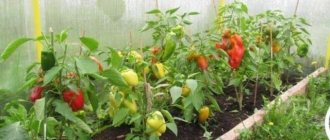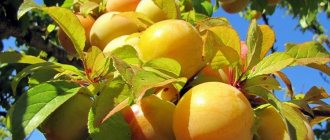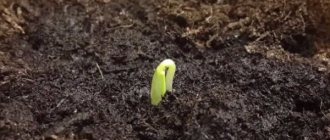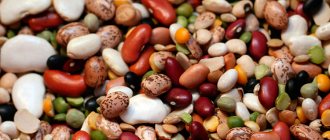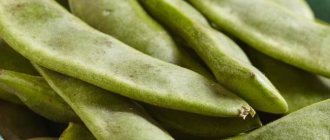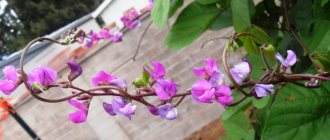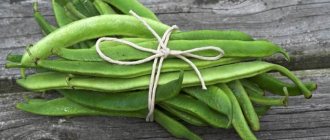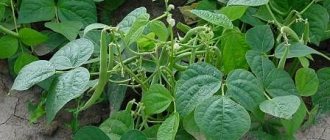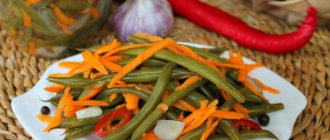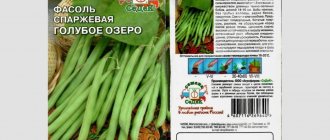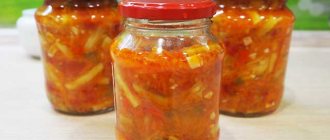General description and characteristics
Beans are an annual plant. It reaches a height of up to 3 m. There are both dwarf varieties and real giants. Depending on the type of bean, the stem can be straight or curly.
The shape of the leaves is trifoliate, the plates are located on long petioles. Holly beans are covered with flowers of all kinds of tones and shades. The flowers look like moths and are collected in axillary racemes.
The fruit of the bean is beans. They ripen in pods that form from flowers. The fruits can be both small and very large. There are straight and curved beans, round and oblong, cylindrical.
The color variety of beans is amazing. They come in white, yellow, red, purple, and black. The skin of some is covered with spots, while others have veins.
Inside the beans there are seeds shaped like an ellipse. Each bean can have from 1 to 3 seeds. Just like beans, they come in a variety of colors.
The degree of fruit ripeness is determined by the appearance of the pods. They look dry and crack when pressed lightly. They also change color, becoming brown.
Black Eyed Peas
The variety was recently bred and is intended for consumption along with the pods, as the name suggests. They are eaten unripe. Depending on the variety, the pods are yellow, white, green or purple.
They are thin, reaching 10-15 cm in length. The flesh is tasty and soft, you can feel the juiciness. The bushes on the site grow compactly, without taking up much space. Green beans are considered a high-yielding crop.
Royal purple pod
Purple pods of 15 cm are intended for canning. The variety is undemanding, so it can be grown without problems.
Deer King
There are white grains inside the pods. Prized for its unusual taste. It produces 2 harvests per season.
Gina asparagus
Early ripening beans. The bushes reach a height of 0.4-0.5 m. The beans are painted a delicate green color. The variety yields consistently and is rarely affected by pests.
Fana
The low-growing plant bears fruit well. Does not require special care from the gardener. Used for winter preparations.
Panther
The pods of the variety have a rich yellow color. The ripening period is average. Suitable for preparing hot dishes and canned for the winter.
Indiana
The seeds of the bush variety have a dazzling white color. The peel is covered with a red pattern. It is considered an early ripening variety.
Pencil Pod
One of the few types of green beans that is consumed fresh. The pods are long and thin, containing black grains inside. Resistant to any weather changes.
Purple Queen
Long pods grow on the bushes of the mid-early bean variety. They have a rich purple color. Perfectly straight with a slight degree of curl.
Olga
Another compact bush that produces tasty pods. Contains a maximum of useful elements for the human body. Thanks to its strong immune system, it easily tolerates various diseases.
Paloma scuba
The growing season lasts from 75 to 80 days. The highest branches reach 0.5 m and do not require support. There are up to 12 beans in a 16 cm long pod. The spatulas are used for cooking, and when dried, only the seeds are used.
Bergold
Delicious green beans, the long pods of which are eaten. For convenience, they are cut into small pieces and frozen in this state. Before use, boil in boiling water.
Basic classification and types
The dominant division is related to regional affiliation.
Experts distinguish two groups:
- American species (Phaseolus L);
- Asian (famous varieties Vigna Savi).
Representatives of the first group are plants with short (5-15 cm) beans and large grains of various colors. By the time the seeds ripen, the flaps of the blades acquire hardness and rigidity due to a special parchment layer. The number of grains most often does not exceed 8-10 pieces.
In Asian species, the beans are long (70-130 cm), elongated, slightly curved. The blades have no hard tufts of fibers and no parchment layer. Inside there are 14-20 small grains. Due to the absence of a parchment layer, such pods are suitable for fresh food (for example, Vigna varieties).
There are more than two hundred natural types of beans, but varieties and hybrid forms bred by breeders are planted on the plots. Cultures are distinguished by plant type:
- bush - compact, low cultivars (25-40cm), characterized by easy care and unpretentiousness. In demand in industrial vegetable growing, recommended for planting in temperate and severe climate zones;
- climbing – liana-shaped plants, with vines up to 3-5 meters. When planting, choose a place near fences, walls, arches, or place special supports. Almost all species are late-ripening, so for cultivation in the conditions of the Urals, Siberia, and the North-West, the harvest in open ground may not wait;
- semi-climbing - the lashes of these plants are of medium length, up to two meters. The variety occupies an intermediate place between the first two groups and requires the installation of supports.
The first group includes the varieties Sweet Courage, Cinderella, Strela. Among the curly ones, Turkish, Violetta, and Gerda are popular.
Green beans
It is also called peeling. The pods of each variety have the same color. On some, a colored but pale pattern is possible.
Inside the blades there are yellow, green, purple, as well as beans of other colors. The fruits contain seeds. Green or shelled beans come in different varieties.
Kenyan
It is considered the most expensive, as it is grown in Africa. The thickness of the pods does not exceed 0.5 cm. They are green in color.
When consumed, nutty notes are felt, as well as a slight sweetness. Due to its soft structure and lack of coarse fibers, it cooks quickly. After a few minutes of boiling, it is added to various dishes.
Pied Pinto
The beans are colored white. The surface of the beans is covered with red spots, which makes them attractive to look at. Characterized by high iron content.
Fava
The pods contain dark brown beans. During the ripening period, they are eaten together with the shoulder blades. When fully ripe, only the beans are used.
Chemical composition and calorie content
Common beans have an immensely rich composition. A special difference is the highest amount of protein compared to other plants.
Mineral content per 100 grams:
| Name | Amount , mg | Name | Amount , mg |
| Phosphorus | 480 | Aluminum | 0,64 |
| Sulfur | 159 | Vanadium | 0,19 |
| Potassium | 1,100 g | Bor | 0,49 |
| Magnesium | 103 | Titanium | 0,15 |
| Calcium | 150 | Nickel | 0,17 |
| Sodium | 40 | Molybdenum | 39,4 |
| Silicon | 92 | Fluorine | 44 mcg |
| Iron | 5,9 | Cobalt | 18.7 mcg |
| Chlorine | 58 | Selenium | 24.9 mcg |
| Zinc | 3,21 | Chromium | 10 mcg |
| Manganese | 1,34 | Iodine | 12.1 mcg |
| Copper | 0,58 |
When preserved, it does not lose its beneficial properties
. Vitamin complex:
| Name | Amount , mg | Name | Amount , mg |
| AT 9 | 0,09 | AT 6 | 0,9 |
| AT 2 | 0,18 | AT 5 | 1,2 |
| IN 1 | 0,5 | RR | 6,4 |
| E | 0,6 | Niacin | 2,1 |
KBJU, calorie content 298 kcal per 100 g :
| Name | Quantity , g | Name | Quantity , g |
| Ash | 3,6 | Water | 14 |
| Alimentary fiber | 12,4 | Fats | 2 |
| Squirrels | 21 | Carbohydrates | 47 |
A very unexpected composition for a plant, but amazingly beneficial for the body.
The only reason you shouldn’t eat this product is your individual intolerance, otherwise you can and should!
Climbing varieties
Beans deserve special attention. The branches reach a length of 5 m, which has an advantage in this regard over other types of beans. Thanks to planting near the support, the branches curl, thereby not taking up space on the site.
Planted only in regions with warm climates. It has a long growing season, so it may not have time to ripen before the onset of cold weather.
Violet
The bean variety is valued by gardeners. The liana reaches only 2.5 m in length. During flowering, deep purple flowers are visible among the dark green leaves. The harvest is harvested 6 weeks after emergence.
Purple Queen
A delicious variety with incredible taste characteristics. The valves are fleshy, purple and suitable for consumption. Green beans have small beans that are creamy and dark yellow in color.
See also
Planting seedlings and seeds, growing and caring for green beans in open ground
Read
Gerda
Due to the absence of a parchment layer and hard fibers, the pods are completely used as food. The first fruits appear early. The maximum length of the pods is 30 cm. They reach 2.5 cm in diameter.
Lambada
The pods are sword-shaped and marbled pink in color. They have a delicate taste and are very juicy. The seeds, as well as the pods, have an interesting color. The peel is covered with streaks and streaks.
Golden nectarine
You can tell the color of a bean by its name. The pods are colored yellow. It takes 2 months from the moment the seedlings emerge until they fully ripen.
Mauritanian
Climbing green beans with early ripening. The foliage is average, the shoots reach 3 m in length. The beans do not have fibers in their structure. Has a high level of productivity.
Fatima
When the beans are ready for consumption, they turn light green. The width of the pods is 3 cm, the length is 20 cm. The pulp of the pods does not have a parchment layer.
Winner
The bean variety is used for cooking and plays a decorative role on the site. The beans ripen within 3 months. There are red flowers on the stems.
Golden neck
The variety bears fruit in black and white beans. The plant prefers sunny areas with light soil. Adapts to unfavorable climatic conditions.
Turk
Often planted for decorative purposes, but not for its pods. The main attraction is the leaves. Cover the stems generously.
Shape and color of beans
Bean fruits come in a variety of colors and shapes. The pods can be long up to 20 cm or shortened 8-10 cm. Their color matches the color of the grains. There are varieties painted in monochrome or variegated shades.
Red
It is most popular in Russia and the countries of the American continent. Slightly inferior in taste to other types. Its grains are fleshy, tasty, and contain a large amount of proteins and antioxidants. The pods are colored pink, red and burgundy.
Varieties include:
- Azuki;
- Ethiopian;
- Kidney;
- Tashkent
White
It is grown in many countries. White grains are nutritious and valued for their high iron content. Due to their low protein levels, they are recommended for dietary use. Dishes made from such beans are prepared faster than from other types of grains. The most common varieties:
- Belozerka;
- Lotus;
- Navy;
- Chali;
- White flat.
Black
The grains are dark purple, almost black. The skin of the peas is shiny with a pearlescent tint. 100 grams contain at least 9 g of protein and a lot of potassium. The beans and pods have a slightly sweet taste. Varieties:
- Black opal;
- Ryabushka;
- Black Pearl;
- Preto;
- Kidney.
Motley
The monochrome color of its fruits (pods and beans) is diluted with lighter or darker inclusions.
- Black eye - the main white color is interspersed with dark spots;
- Pinto - a beige shade interspersed with brown and red dots;
- Swallow - The white skin has a darker swallow-wing pattern.
Advice.
You can speed up the cooking of beans by soaking the beans for 3-4 hours in water at room temperature. Cooking time will be reduced by 10-15 minutes.
Ripening time
According to the growing season, beans are divided into groups: early, mid-season and late varieties. The longest period of time from the appearance of the first shoots to the beginning of fruiting is found in crops that ripen at 130-140 days. After 80-100 days, varieties of medium ripening periods begin to bear fruit. Early crops produce the first harvest after 65-80 days.
Bush varieties
Usually these are low-growing varieties of beans, 25-60 cm in height. Selected for large-scale cultivation. The bushes unanimously produce a harvest that ripens quickly. Easily tolerates the coldest days and nights during growth.
Popular varieties are:
- Fana;
- Royal Purple Pod;
- Deer King.
Caramel
Growth time occurs from May to June. The beans yield their harvest gradually, so the pods are harvested within 2-3 months. It is eaten together with the pods.
Little Red Riding Hood
The vegetable has an unusual color. There is a huge red spot near the eye, while the entire bean is white. During growth it forms a spreading bush.
Yin Yang
It is unique due to its pattern, which cannot be found in any other variety. It really has symbols of feminine and masculine energy.
Butter King
The variety ripens early - 1.5 months after planting the seed in the soil. The yellow pods reach 25 cm in length.
Bean varieties for growing in different regions
Agrotechnical techniques and rules for growing beans in the southern and northern regions, in the east and west of the country are practically no different from each other. The only differences are in the approaches to improving the physical and chemical state of the soil and the sowing calendar. To obtain a good harvest, it is important to correctly determine the type of crop and the method of growing beans: in open or protected ground, by seedlings or by sowing seeds directly into the ground.
The State Register of Breeding Achievements does not differentiate bean varieties by regions of approval and indicates that all of them can be grown in all regions of the country. Analyzing the information presented in the characteristics of the varieties, as well as the fact that in the northern regions it is preferable to grow earlier ripening varieties, we will allow ourselves to create a recommendation table of bean varieties included in the State Register for various regions of the country.
Table: bean varieties for different regions
| Countries, regions | Varieties of grain beans | Varieties of vegetable beans |
| Southern regions of the Russian Federation, Ukraine, Caucasus | Ballad, Varvara, Heliad, Housewife's Dream, Snezhana, Stanichnaya | Amalthea, News, Dialogue, Zinaida, Goldilocks, Hope, Luck |
| Siberia, Far East, Ural | Lukerya, Olive, Light, Ufimskaya | Anfisa, Viola, Darina, Gold of Siberia, Emerald, Marusya, Nika, Solnechnaya, Sibiryachka, Yubileynaya |
| Moscow region, Volga region, central part of the Russian Federation | Oran, May Day, Arrow, Chocolate Girl | Antoshka, Galepka, Cinderella, Lacemaker, Butter King, Purple Queen, Sweet Courage |
| North-West region | Golden, Ruby, Lilac | Bona, Crane, Pagoda, Welt, Santa without fiber 615, Second, Flamingo |
Whatever variety of beans you choose to plant on your plot, in any case you will receive a unique protein supplement for various dishes, which also contains many useful vitamins and microelements.
- Author: Lyudmila Bartasevich
My name is Ludmila. Higher education, graduated from the Minsk Institute of Culture. I live in Belarus. Rate this article:
- 5
- 4
- 3
- 2
- 1
(19 votes, average: 4.5 out of 5)
Share with your friends!
Red beans
The rich reddish grains are rich in vitamins and other beneficial substances. The chemical composition of beans has a beneficial effect on the body. When cooked, the beans slightly change color, becoming several shades lighter.
Skorospelka
The name of the bean variety confirms the rate at which the beans ripen. The fruits are oblong in shape from 1 to 2 cm. Most of the skin is pinkish-red. Beige specks are occasionally visible.
Tashkent
The culture loves warmth, so it is planted in the southern regions. In temperate climates, a good harvest is obtained using the seedling growing method. The variety is characterized by large fruit.
Medium red
Reddish beans lose some color intensity after cooking. Tasty and healthy.
Tomato
The variety is successfully used for preservation. Suitable for preparing Georgian dishes. The seeds are flattened, oblong in shape.
Azuki
The Himalayas are considered the birthplace of beans. Successfully cultivated in southern Asia and Japan. Seeds are rich red.
Ethiopian
Another variety of red beans. Used for preparing fresh dishes.
White varieties
The grains are painted white, which sometimes reaches a light milky tint. As a rule, they have a solid structure. It has a high protein content, so it is a must for consumption.
Chali
The variety is characterized by large beans that are completely white.
Black eye
Thin pods with original grain appearance. There is a black spot near the eye. The seeds cook quickly because they have a soft structure.
Navy
They resemble beads in shape, as they are small in size. Rich in vitamins.
White flat
An early ripening bean variety with climbing stems. Gives a high yield at the moment of ripening.
Lotus
The low-growing bush is decorated with straight, light yellow pods. Free from fibers, therefore soft and tender.
White mares
They are often found in the garden, but are not as popular as other varieties.
Belozerka
Another variety that vegetable growers don’t often think about.
Black varieties
Richly colored beans are rich in vitamins. It is popular among chefs when preparing Latin American dishes. The taste has sweet and smoky notes.
An interesting fact is that the darker the color of the beans, the more nutrients they contain. The rich chemical composition confirms this.
Kidney
The shape of the beans resembles kidneys. Purple and red beans are harvested from one bush.
Preto
The creamy pulp of the beans is covered with a black skin. When the beans are cooked, the aroma of the berries is felt.
Grain beans
Obtained by growing shelling varieties. It is not only nutritious, but also very healthy. Suitable for long-term storage without pre-treatment. To speed up the cooking time, soak it in water for 3-5 hours before cooking. The pods are not used for food.
Chocolate girl
The plant loves sunny areas and pleases with a large number of pods. In turn, they contain beans of a rich brown color.
Ballad
The bushy plant is covered with pink flowers and diamond-shaped leaves. The seeds are beige in color with purple streaks.
Housewife's dream
The compact plant is decorated with flat green beans without fibers or a parchment layer. At the moment of technical maturity, the seeds are white.
Ruby
The grains are dark cherry in color. The fruits are so beautiful that it seems they are not intended for cooking.
Some varieties of beans are actually used to create decorative items.
Golden
The color of the seeds is completely opposite and does not correspond to the name. Used as a base for preparing main courses and desserts.
Gribovskaya-92
The beans are colored white. The peel has an even tone and is free from specks and inclusions.
Gorgeous
The plant is compact in size and produces a mass of pods with interestingly colored grains.
Large varieties
The seeds extracted from beans are enormous in size. When cooked they double in size. Nourishing and tasty.
Baby Lima
Thanks to the outer shell, the shape of the bean is perfectly preserved during heat treatment.
Anniversary
Famous for its beautiful crimson beans covered with white specks.
See also
What to do if there are bugs in beans, pest control measures and prevention
Read
Moscow white
The bushes yield a harvest together and have a universal purpose.
Gardener
The grains are chestnut-colored with reddish spots. The yield is stable and care is unpretentious.
polar Star
Unlike other bean varieties, it has the shortest growing season.
Pink
The marbled pink beans contain 6-10 grains.
Varieties by ripening time
Like other vegetable crops, they have early, medium and late ripening periods.
Early and mid-early
When harvesting this type of bean, it is important not to miss the right moment. Soft and green pods quickly become coarse and change their taste. Regular harvesting promotes the formation of new beans.
Flat long
Dark green beans growing on climbing stems.
Belozernaya 361
Despite its early ripening period, it is used for different purposes.
Saxa 615
The beans have a sugary and delicate taste. Fruiting is extended.
Homestead
Ultra-early ripening green beans.
Shahinya
Light green beans reach 10-12 cm in length.
Golden Nectar and Caramel are varieties with early ripening.
Average by ripening period
Some varieties of beans will always be on the table in the first half of summer. They begin to bear fruit after the early ones.
Bush without fiber B-85
The sugar variety is suitable for canning.
Moscow white
Forms small compact bushes from which it is convenient to harvest.
Green-green B-556
The white flowers develop into green pods surrounded by yellow-green shiny foliage.
Golden Mountain B-632
Immature pods are yellow in color. There are black seeds inside.
Wide-shafted 92
The pods are collected as they ripen, as the flesh quickly becomes coarse. Sword-shaped beans.
Pation
The variety adapts to unsuitable climates and other stressful conditions.
Motol white
A variety of beans that came from Belarus. At the moment of ripening, the pods do not crack and do not destroy the seeds.
Yubileinaya 287
The tip of the pod is curved to the side. The taste is rated at the highest level.
Fire red
The vegetable variety is devoid of coarse fibers. Dark green beans are harvested 3 months after sowing the seeds.
Purple
Bean pods have an interesting feature. At the time of growth, the pods are colored green. If the length reaches 10 cm, the color changes to purple.
Pobeditel also belongs to bean varieties with an average ripening period.
Late and late ripening
There are different varieties presented in this category. They were bred for areas with warm and long summers.
Handsome Yas
Planted to collect dry grain. During growth it does without support. Loves warmth and produces large seeds.
Blue Hilda
One bush produces up to 12 pods per season. Collection begins 2 weeks after the formation of the ovary.
Queen Neckar
A plant with a height of 3 m produces white flowers.
Sowing technology
Growing a good harvest of asparagus beans in open ground will not be difficult if you choose a suitable place for this crop and strictly follow agricultural practices.
Local climatic conditions must be taken into account.
Combination with other plants
Legumes, including green beans, cannot be planted in one place every year.
Good predecessors for this vegetable will be various root vegetables (beets, carrots, etc.), nightshades (eggplant, tomatoes, potatoes, etc.), cruciferous vegetables (cabbage, radishes, etc.).
After other representatives of the legume family (peas, beans), this plant develops poorly.
It is useful to plant green beans in the country, alternating with cucumbers, cabbage, pumpkin, onions and other vegetable crops.
How to prepare the soil and seeds?
The area for green beans should be prepared in the fall. To do this, dig up the ground with the addition of humus (4 kg), dolomite flour or fluff (2 tbsp), superphosphate and saltpeter (1 tbsp each) per 1 m².
It is recommended to add sand (5 kg per 1 m²) to heavy and viscous soil.
A few hours before planting, the prepared bed is watered with a weak solution of potassium permanganate for disinfection.
Before planting, planting material must be sorted, discarding seeds with any damage or defects.
The largest and most undamaged specimens are left. Then they are soaked for 10-12 hours in warm water (+35...+40°C).
Seat
For asparagus green beans, a heated and well-lit area with fertile black soil in a place protected from the winds is suitable.
You can place it along walls or fences, but it is better on the eastern side so that the sun's rays fall on the plantings in the afternoon.
The soil should be loose, permeable to moisture, and have a neutral or slightly alkaline reaction.
Acidic soil is first deoxidized with ash or fluff.
This culture does not like clayey, wet and nitrogenous soils, as well as close groundwater.
Step by step: from soaking to support
Sowing is carried out based on local climatic conditions.
Tender sprouts die at temperatures below +5°C.
The technology for growing beans includes the following steps:
- planting material is soaked for a day in a warm solution of potassium permanganate;
- just before sowing, well-swollen seeds are dipped in a solution of boric acid (10 g per 1 liter of water) for 2-3 minutes to protect them from parasitic insects;
- dig grooves 5-6 cm deep and water them generously with warm water;
- seeds are planted in the spilled furrows (no deeper than 4 cm);
- then the ground is leveled and covered with a layer of humus;
- to speed up germination, it is recommended to cover the bed with plastic wrap;
- shoots appear after 7-10 days;
- shoots are thinned out, leaving a distance between them of at least 10-15 cm (bush) and 25-30 (climbing);
- Plants that have grown to 10-12 cm are hilled so that there is more space for root growth;
- for climbing varieties, a support about 2 m high is organized for branching, to which the bush is tied after the arrow appears.
The distance between furrows is maintained at 25-30 cm for bush forms and 45-50 cm for climbing varieties.
Recommendations for different regions
Breeders have developed many varieties for open ground. Taking into account climatic conditions, there are varieties for growing in warm and cold weather.
For Siberia
Many people associate this region with cold. Despite this fact, summer is warm, but short. Therefore, varieties with a short growing season are grown in the area.
Sugar variety Green-pod-517
The long pods with brown seeds are used for canning.
Semi-sugar variety Moscow white green-pod-556
It stands out among other varieties by two properties:
- resistance to various diseases;
- adaptation to temperature changes.
The plant grows up to 40 cm without interfering with neighboring vegetables in the garden.
Bush peeling variety Early ripening
Planted to collect elastic grains. The pods crack easily, allowing the seeds to be removed from the beans.
North Star 690
Due to the rapid hardening of the blades, it is unsuitable for canning.
Semi-sugar variety Gribovskaya-92
Despite the fact that the variety is shelled, the pods for consumption are collected at a young age.
Triumph sugar 764
High yielding green beans. The pink flowers form straight, long pods. Taste like sugar, without coarse fibers.
Siberian size
The variety bears regular black seeds. Temperature fluctuations and unfavorable climatic factors do not affect the appearance and taste of the fruit.
Yunnan
From the name you can guess that the birthplace of beans is China. Often grown in gardens after improvement by Russian breeders.
Saxa without fiber-615
It is an analogue of Saxa, but has one main difference - the absence of coarse fibers, which is already clear from the name.
Generous
The harvested crop is used for fresh consumption and for the preparation of canned dishes. Beans are extremely tasty and healthy.
For Southern regions
The developed varieties tolerate drought, which does not affect the yield level.
Rachelle
A universal variety that tolerates drought and waterlogging. Withstands short cold spells. Up to 30 beans are formed on one bush.
Creole
Suitable for growing on farms and home gardens.
Antoshka
High-yielding variety with semi-sugar tender and soft beans. The stems of the variety are climbing.
Firefly
Characterized by a bouquet arrangement of the shoulder blades. It is eaten in the form of grains, as well as with shoulder blades. Suitable for freezing.
Lika
A variety included in the group of the best for winter harvesting. The fibers of the pods remain soft for a long time. It is a sugar-asparagus type.
Ol-tyn
Long beans are covered with faint purple streaks. The grains are brown in color with richer stripes.
The list of varieties intended for cultivation in the southern regions also includes the Yubileynaya 287 vegetable variety.
For the middle band
This region has a wide variety of climatic conditions. Despite the fact that summer is longer, some varieties do not have time to fully ripen.
Fantasy
It obtains high taste as a result of growing on soils with a high humus content. Brings a stable harvest. The purpose is universal.
Sakfit
It acquires an incredible taste after cooking. Does not suffer from anthracnose, tolerates cold and humidity.
Welt
The pods of semi-sugar beans are green in color. They are of medium size.
Martin
The grains are white, diluted with purple spots. When you see the drawing, it seems that birds are drawn.
Contender
A variety of green beans that produces long, fleshy and juicy beans. Delicious, soft, without a parchment layer. Ripening occurs 2 weeks earlier than early potatoes.
By method of use
The culture of eating beans has its own history. There were times when the product was considered food for rude commoners, and only aristocrats feasted on the pods.
Today there are hundreds of dishes made from colored beans . The pods and beans are dried, pickled, and prepared into salads, soups, and national dishes.
Considering the difference in consumption, the vegetable is divided into:
- peeling;
- asparagus;
- semi-sugar.
Luschilnaya
This species has only edible seeds. To obtain them, the beans are first shelled. The process determined the name of the species - shelled beans. Its pods are hard, tough, with a waxy coating. And the beans taste wonderful and are nutritious.
Hulling varieties are late-ripening. In central Russia they do not have time to ripen.
Asparagus
Green beans give themselves completely to food - both pods and grains . While the vegetable ripens, the pods remain juicy and tender. Even after full ripening, a hard layer does not form inside the pod. Therefore, for pickling and freezing, the entire blade is used (this is what unripe seeds in a box are called). Green beans can have either climbing or bush forms.
Semi-sugar
In semi-sugar varieties, coarse fibers form in the pod, which are removed before consuming the fruit. A parchment coating forms on some types of grains. Ripening lasts about one hundred days.
Beans of these varieties are consumed only when unripe. After the formation of the parchment layer, they are hard. Ripe seeds are husked and used.
